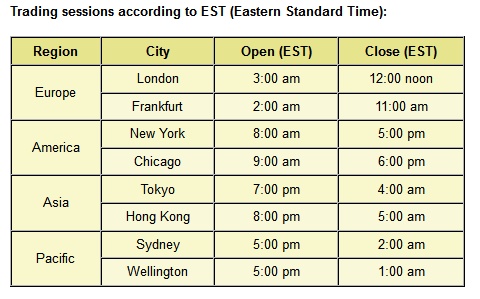Forex trading timing at different sessions
Summer (approx. April – October)
Time Zone EDT GMT
Sydney Open
Sydney Close
6:00 PM
3:00 AM
10:00 PM
7:00 AM
Tokyo Open
Tokyo Close
7:00 PM
4:00 AM
11:00 PM
8:00 AM
London Open
London Close
3:00 AM
12:00 PM
7:00 AM
4:00 PM
New York Open
New York Close
8:00 AM
5:00 PM
12:00 PM
9:00 PM
Winter (approx. October – April)
Time Zone EST GMT
Sydney Open
Sydney Close
4:00 PM
1:00 AM
9:00 PM
6:00 AM
Tokyo Open
Tokyo Close
6:00 PM
3:00 AM
11:00 PM
8:00 AM
London Open
London Close
3:00 AM
12:00 PM
8:00 AM
5:00 PM
New York Open
New York Close
8:00 AM
5:00 PM
1:00 PM
10:00 PM
Actual open and close times are based on local business hours. This varies during the months of October and April as some countries shift to/from daylight savings time (DST). The day within each month that a country may shift to/from DST also varies.
You can see that in between each forex trading session, there is a period of time where two sessions are open at the same time. During the summer, from 3:00-4:00 am EDT, the Tokyo session and London session overlap, and during both summer and winter from 8:00 am-12:00 pm ET, the London session and the New York session session overlap.
Naturally, these are the busiest times during the trading day because there is more volume when two markets are open at the same time. This makes sense because during those times, all the market participants are wheelin’ and dealin’, which means that more money is transferring hands.
Now, you’re probably looking at the Sydney open and thinking why it shifts two hours. You’d think that Sydney’s open would only move one hour when the U.S. adjusts for standard time, but remember that when the U.S. shifts one hour back, Sydney actually moves forward by one hour (seasons are opposite in Australia). You should always remember this if you ever plan to trade during that time period.
Let’s take a look at the average pip movement of the major currency pairs during each forex trading session.
Pair Tokyo London New York
EUR/USD 76 114 92
GBP/USD 92 127 99
USD/JPY 51 66 59
AUD/USD 77 83 81
NZD/USD 62 72 70
USD/CAD 57 96 96
USD/CHF 67 102 83
EUR/JPY 102 129 107
GBP/JPY 118 151 132
AUD/JPY 98 107 103
EUR/GBP 78 61 47
EUR/CHF 79 109 84
From the table, you will see that the European session normally provides the most movement.
Let’s take a more in-depth look at each of the session, as well as those periods when the sessions overlap



